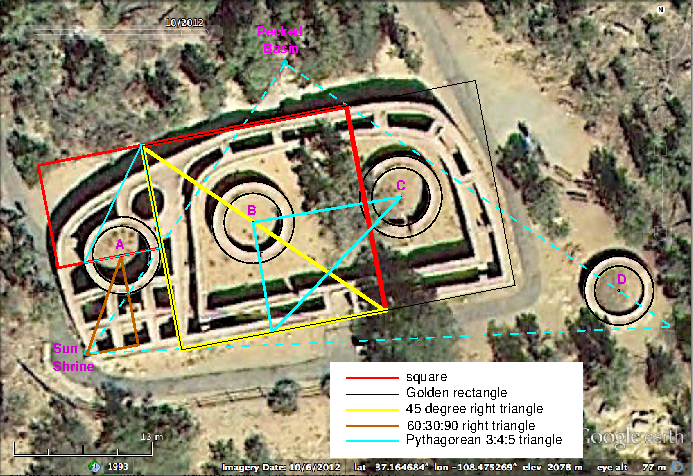Ancient Pueblo Used Golden Ratio to Build the Sun Temple

The Great Pyramids in Giza, the Parthenon in Athens and Chichen Itza in Mexico have something in common. Besides attracting hordes of tourists, all of these architectural wonders appear to use the golden ratio.
This mathematical number is often written as 1.618, the first few digits of its infinite decimal form. Expressed another way, two quantities —let's call the larger one "a" and the smaller "b" —are in the golden ratio if "a is to b" as "a + b is to a." The result is a composition with aesthetically pleasing proportions.
Now, shapes with the golden ratio, as well as other geometric shapes, have been found in another, unexpected site: the Sun Temple at Mesa Verde National Park in Colorado, built by the ancient Pueblo people who lived in what is now the modern-day Southwest; they had no known written language or written number system. [Chaco Canyon Photos: The Center of an Ancient World]
Sherry Towers, a physicist and statistician at Arizona State University, had been surveying the 800-year-old ruins of the D-shaped temple. She was originally interested in whether this carefully constructed ceremonial temple —which was already thought to be aligned with the solar solstice and lunar standstill (the point at which the moon appears to reverse its path from north to south or south to north) —was also used as an astronomical observatory for people of its time to watch celestial bodies, like the Pleiades and Vega.
"I noticed in my site survey that the same measurements kept popping up over and over again," Towers said in a statement from ASU. "When I saw that the layout of the site's key features also involved many geometrical shapes, I decided to take a closer look."
In the layout of the site, Towers documented rectangles using the golden ratio as well as other geometric shapes such as equilateral triangles, squares, 45-degree right triangles and Pythagorean triangles.
This means that the Sun Temple could represent one of the earliest examples in prehistoric North America of knowledge of several geometrical constructs, Towers wrote in her study, which is detailed in the April issue of the Journal of Archaeological Science: Reports.
Sign up for the Live Science daily newsletter now
Get the world’s most fascinating discoveries delivered straight to your inbox.
"Given that the ancestral Pueblo peoples had no written language or number system, the precision of such a layout would be a remarkable feat," Towers wrote. "It is unclear why these ancients potentially felt the need to employ these constructs in the Sun Temple site. Perhaps the specialized knowledge of how to construct these shapes with a straightedge and a cord formed part of the inherent mysticism of the ceremonial nature of the site."
However the temple was constructed, Towers wrote that the apparent care with which it was designed at least supports the idea that this site was important for ceremonies and rituals in the region. And even with low-tech methods, the measurements of these shapes at the Sun Temple had a relative error of less than 1 percent, she added. The shapes also seem to use a common unit of measurement equal to about 1 modern-day foot (just over 30 centimeters), which is why Towers says she think the shapes aren't just a random chance occurrence in her analysis.
She wants to investigate whether these units and shape are also used at other ancestral Puebloan ceremonial sites, such as Pueblo Bonito, in New Mexico's Chaco Culture National Historical Park.
"Further study is needed to see if that site also has the same common unit of measurement," she said. "It's a task that will keep us busy for some years to come."
Original article on Live Science.











